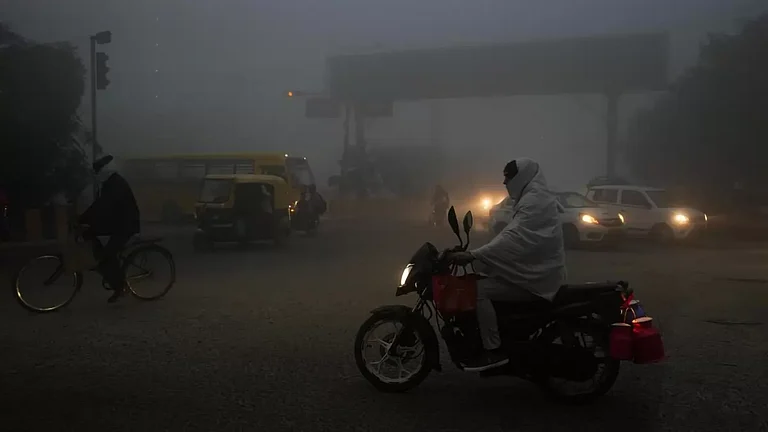It is a fact commonly acknowledged that cutthroat, pre-poll dealings are garnished, for the public and their mediators, the media, with sumptuous photo-ops rich in symbolism. Thus, Congress leader and MP Rahul Gandhi found a way into the hearts of Tamils—through their palates. During his recent tour of the state, the Congress leader joined members of the popular Village Cooking YouTube Channel to help prepare onion raitha to accompany the mushroom biriyani the members had prepared for him. Earlier, during his three-day road show in four western districts of the state, Rahul hopped into roadside tea stalls to sip chai and munch on butter biscuits with locals and party workers, lunch (on banana leaves) with women workers of a spinning mill and take selfies with all.
“He was extremely approachable and informal, and clad like a teenager in jeans and a T-shirt. For people used to politicians in their starched veshtis and shirts, he was a breath of fresh air. He definitely scored through his optics, coming across as an affable and approachable leader,” says K. Manimaran, a data entry operator in Tiruppur. The real political optics, however, lay elsewhere.
The standalone campaign of Rahul even before election dates have been announced was a departure from the past, when he used to share the stage with top DMK and Congress leaders after seat-sharing had been finalised. Coming well ahead of that exercise, the solo show by the Congress was aimed at letting their allies know that the Congress can take care of its vote banks without depending on the DMK. “The western and southern districts of Tamil Nadu have always been favourable to the Congress and we wanted to directly connect with voters there first. Also, the industrial belt of Coimbatore, Tiruppur and weavers of Erode and Karur districts have been hit badly by the economic policies of the Modi government. Sharing their concerns became a priority,” points out Karur Congress MP Jothimani.
This new confidence, leading to striking out on his own, found expression in Rahul’s speech. While he talked about a change of government in the state he never mentioned the DMK or its leader Stalin spearheading that change. The silence on Stalin was all the more telling since the DMK president was the only non-Congress leader who openly projected Rahul as a prime ministerial candidate in 2019.
By choosing the western districts in the first leg, the Congress sent out an indirect message that the DMK, which was weak in these parts, needed the support of the Congress to upset the AIADMK in its bastion. The second leg will take Rahul to the southern districts, where the Congress has a decent footprint too, to emphasise the same line—the DMK needs the Congress to win in these areas. “It’s a clever defensive strategy by the Congress after its Bihar debacle. It apprehends that the DMK might pare down its seat share below 20, which will be a direct snub to the national party. Since the Congress could win just 8 out of the 41 assembly seats in 2016, the DMK has been under pressure to prune its share. Bihar proved that the Congress was a deadweight. Rahul wants to reverse that impression with his solo campaign in Tamil Nadu,” explains political commentator Raveendran Thuraiswamy.

Kamal Haasan campaigns for his MNM in Coimbatore.
The Congress also opened another flank to pressurise the DMK as it wooed Kamal Haasan’s Makkal Needhi Maiam (MNM). The party’s Sivaganga MP Karti Chidambaram openly invited Kamal to join their front to improve his winning chances. Ideally, the invite should have been extended by senior ally the DMK. “There is nothing wrong in the Congress extending an invitation to Kamal Haasan since both our parties share similar ideologies and believe in inclusive culture. We would not only be strengthening an already winning alliance but also improving the chances of Kamal’s fledgling party,” explained Karti.
DMK leaders see this as an indirect threat by the Congress to create its own grouping within the alliance to improve its bargaining position. “Maybe they want to keep a third front along with the MNM as plan B in case the number of seats falls below their expectations. It could also be a response to the DMK attempting a larger role for itself in neighbouring Pondicherry in the next government,” observes a DMK MP. Karti, however, insists that any lasting truck with MNM must have the DMK’s approval and only the latter would have to hold seat sharing talks with Kamal Haasan.
Kamal, for his part, has been non-committal about striking a deal with the Congress or other disgruntled parties like the PMK (Pattali Makkal Katchi) and T.T.V. Dhinakaran’s AMMK (Amma Makkal Munnetra Kazhagam). “We will ally with only good people,” he insists. There is every likelihood that he would finally parachute into the DMK-led basket by stating that the common enemy is the ruling AIADMK. In a recent interview, he compared the AIADMK to jaundice that needs to be tackled with greater urgency than typhoid (the DMK), for which only a vaccine was needed.

Rahul has a meal with a supporter during Pongal in Madurai.
The DMK appears wary of Kamal Haasan, since the MNM could erode its voteshare in urban seats. In the 2019 Lok Sabha elections, though it managed to poll only four per cent of votes, the MNN polled over ten per cent in four urban seats. Since many assembly seats fall smack in urban areas, the MNM could dent the DMK’s reach amongst uncommitted voters here.
In the AIADMK-led rival alliance, the PMK has been flexing its caste muscle, demanding a 20 per cent reservation for Vanniyars before seat-sharing talks. The ruling party has been non-committal, since any such assurance would only antagonise other communities. Similarly, Vijayakanth’s DMDK (Desiya Murpokku Dravida Kazhagam) has been urging the AIADMK to include Sasikala, recently released from jail, in its calculations while forming an alliance. DMDK treasurer Premalatha Vijayakanth further embarrassed the AIADMK leadership by insisting that Chief Minister K. Palaniswami was not the people’s choice, but nominated to the post by Sasikala. “Jayalalitha showed in 2016 that she could brush aside allies, contest the elections alone and still win a majority. But poor EPS is politically so weak that he is being pushed around by prospective allies,” observes a senior IAS officer.
The threat of a third front has been a handy tool to increase the bargaining clout of smaller parties in Tamil Nadu, though such alliances have always finished a distant third. The PMK is a past master at it, though it has often come a cropper while fighting alone, like in 2016. The communists formed a third front along with DMDK, VCK and TMC in 2016, only to draw a blank. Yet such bad experiences do not deter smaller players from using it as a gambit. It is up to the big brothers—DMK and AIADMK—to call their bluff.
By G.C. Shekhar in Chennai


























